#Guion Bluford
Text
THE SPACE RACE
The long, hard journey
To put black men into space
A hard won battle
youtube
#the space race#random richards#poem#haiku#poetry#haiku poem#poets on tumblr#haiku poetry#haiku form#poetic#nichelle nichols#walter cronkite#Mae C. Jemison#octavia butler#Lisa Cortes#Diego Hurtado de Mendoza#mark monroe#sun ra#Leland Melvin#disney+#national geographic#H. rap brown#Adam Clayton Powell Jr.#ed Dwight Jr.#Ralph Abernathy#Guion Bluford#Ron McNair#Charles Bolden#victor glover#nasa
1 note
·
View note
Text
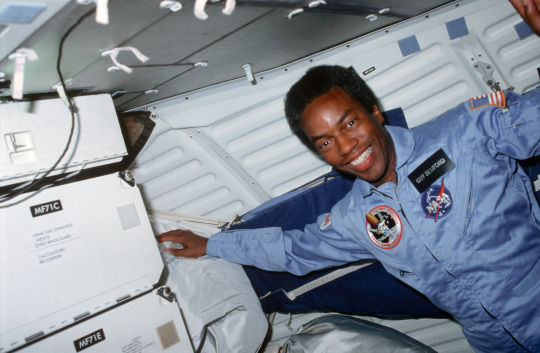
Guy Bluford Changed the Course of Space History
On Aug. 30, 1983, Guion Bluford, better known as Guy, became the first African American to fly to space. An accomplished jet pilot and aerospace engineer, Bluford became part of NASA’s 1978 astronaut class that included the first African American, the first Asian American, and the first women astronauts.
He and the other crew members of mission STS-8 were aboard the orbiter Challenger as it lifted off from Kennedy Space Center in Florida; it was the first nighttime launch and landing of the Space Shuttle program. While aboard, he and the other crew members deployed the Indian National Satellite (INSAT-1B), operated a Canadian-built robot arm, conducted experiments with live cell samples, and participated in studies measuring the effects of spaceflight on humans.
youtube
Guy Bluford chased his childhood dream of becoming an aerospace engineer, and in doing so, changed history and encouraged other Black astronauts to follow in his footsteps.
Make sure to follow us on Tumblr for your regular dose of space—and for milestones like this!
4K notes
·
View notes
Photo

Guion Bluford became the first African American to go to space as the Space Shuttle Challenger lifted off on August 30, 1983.
Record Group 330: Records of the Office of the Secretary of Defense
Series: Combined Military Service Digital Photographic Files
Image description: The Space Shuttle Challenger is lifting off at night. The cloudy plume surrounding it is lit dramatically.
#archivesgov#August 30#1983#1980s#NASA#space#space shuttle#Challenger#liftoff#dramatic lighting#chiaroscuro
238 notes
·
View notes
Text

Ronald McNair was 9 when a South Carolina librarian told him he could not check out books from a segregated library in 1959. Refusing to leave, a determined McNair sat on the counter while the librarian called the police, as well McNair's mother. The police arrived, told the librarian to let the young boy have his books, and McNair walked out alongside his mother and brother.
McNair went on to earn his Ph.D. in physics at MIT and became one of the first African Americans selected as astronauts by NASA, alongside Guion S. Bluford, Jr. and Frederick Gregory.
McNair's first spaceflight was the STS-41B mission, aboard the "Challenger" shuttle. He successfully maneuvered the robotic arm, which allowed astronaut Bruce McCandless to perform the first space walk without being tethered to the spacecraft.
The second space flight for McNair would be his last. He, along with six other NASA astronauts, were aboard the Space Shuttle Challenger when it exploded 73 seconds after takeoff in 1986. Everyone on board the shuttle was killed.
Today, the library in South Carolina where McNair was refused books is named after the heroic boy determined to make a difference.
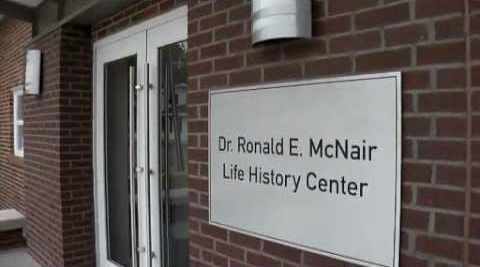
•••
Ronald McNair tenia 9 años cuando una bibliotecaria de Carolina del Sur, le dijo que no podía sacar libros de una biblioteca segregada en el año 1959. Rehusándose a irse,un McNair muy determinado, se sentó en el mostrador mientras que la bibliotecaria llamaba a la policía y también a la madre de McNair. La policía llegó, le dijeron a la bibliotecaria que dejara que el niño sacara los libros. McNair salió de la biblioteca junto a su madre y hermano.
McNair ganó su doctorado en física en el Instituto Tecnológico de Massachusetts (MIT) y se convirtió en uno de los primeros afroamericanos en ser seleccionado como astronauta por la NASA, junto con Guion S. Bluford, Jr. y Frederick Gregory.
El primer viaje espacial de McNair fue la misión STS-41B, abordo del transbordador espacial llamado Challenger. Logró maniobrar el brazo robótico de manera exitosa, esto permitió que el astronauta Bruce McCandless realizara la primera caminata espacial sin estar atado a la nave espacial.
El segundo viaje espacial de McNair, fue su último. Él, junto con otros seis astronautas de la NASA estaban abordo del transbordador espacial Challenger, cuando este explotó 73 segundos después de su despegue en 1986. Todos los que estaban a abordo de la nave fallecieron.
Hoy, la librería en Carolina del Sur, dónde le negaron los libros a McNair, ahora se llama igual al niño heroico que estaba determinado a hacer la diferencia.
#blacklivesmatter#blacklivesalwaysmatter#english#spanish#blackhistory#history#share#read#blackhistorymonth#blackpeoplematter#knowyourhistory#historyfacts#blackbloggers#black history is american history#blackboysrock#blackhistoryyear#culture#follow#black history#blackownedandoperated#library#nasa#black history month#black lives matter#black history is world history#black history matters#black history is everybody's history#black history 2023#black tumblr#black owned
270 notes
·
View notes
Text

The charged particles from the Sun strike Earth's magnetosphere to create the Aurora Australis and are captured during STS-39 Discovery.
"Moonlight saturates the high speed film used for auroral photography. Moon glint is visible in the open ocean and the cloud patterns are well illuminated. This frame was taken with a handheld 35mm camera from inside the Space Shuttle Discovery's crew cabin. This is one of 25 visuals used by the STS-39 crew at its May 17, 1991 Post Flight Press Conference (PFPC). Discovery's flight of eight days duration, launched April 28, 1991 from Kennedy Space Center (KSC) and completed on May 6, 1991 at the KSC landing facility, was dedicated to the Department of Defense (DOD). Crew members were astronauts Michael L. Coats, L. Blaine Hammond, Guion S. Bluford, Richard J. Hieb, Gregory J. Harbaugh, Donald R. McMonagle and Charles L. (Lacy) Veach."
Date: April 28 - May 6, 1991
NASA ID: STS039-377-013, STS039-377-013
#STS-39#Space Shuttle#Space Shuttle Discovery#Discovery#OV-103#Orbiter#NASA#Space Shuttle Program#Aurora Australis#Aurora#Space#Earth#April#May#1991#my post
27 notes
·
View notes
Text
MAJOR MATT MASON - MAN IN SPACE

Major Matt Mason, Mattel’s Man in Space. This is an original 1966 release, as the straps on his space suit are blue. All subsequent versions of the figures had black straps.
Mattel took full advantage of young Americans’ fascination with the space program by releasing the Major Matt Mason line of astronaut action figures in 1966.

Sgt. Storm on the Space Sled, a flying jet ski-like personal transport.
There were initially three color-coded 6-inch astronaut figures in the line: Major Matt Mason was in a white space suit, Sgt. Storm was in a red space suit, and Mason’s civilian scientist buddy, Doug Davis, wore a yellow suit. In 1968 a fourth astronaut, African-American Jeff Long, made the scene in a blue spacesuit.
Long’s addition to the line was a bold move on Mattel’s part, as the astronaut program at NASA during that time was lily white.
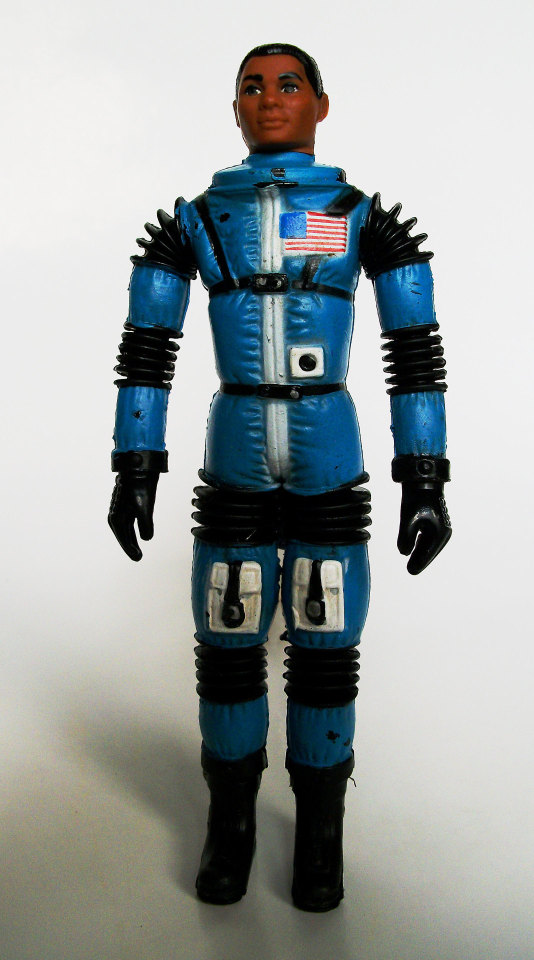
Astronaut Jeff Long, who appeared nearly 20 years before Guion Bluford became the first black American to orbit Earth.
The figures were a rubber-like body over a thin wire armature - similar to the Gumby and Pokey toys - with molded plastic heads. The wire armatures and pliable bodies made the figures extremely posable.
All four astronauts lived and worked on the Moon, which was pretty darn cool. The coolest thing about the Major and his crew, though, was that - initially, at least - all their equipment was based on actual designs and prototypes developed for the space program.
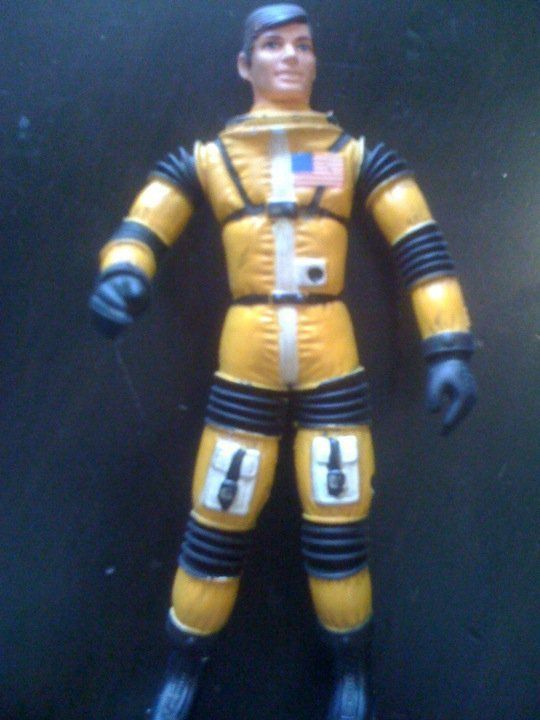
Doug Davis, first civilian on the Moon.
And boy, was there a LOT of equipment and accessories: a flying Space Sled, a Cat Trac one-man tractor, a moon suit, a Space Crawler that used rotating “legs” instead of wheels, and a whole bunch more up to and included a multi-storey Space Station play set (although it really was a Moon Base).
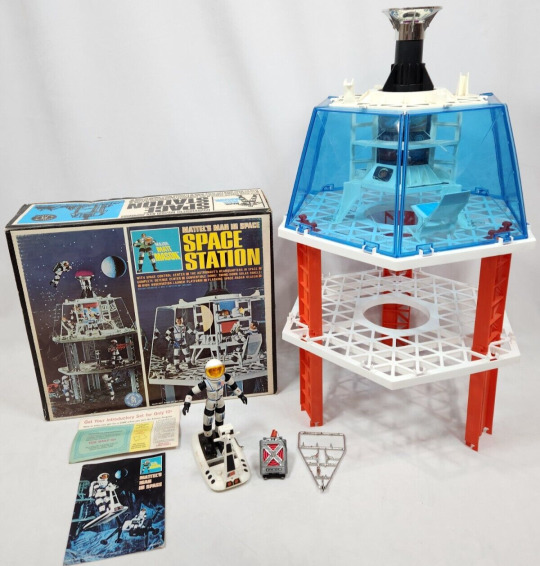

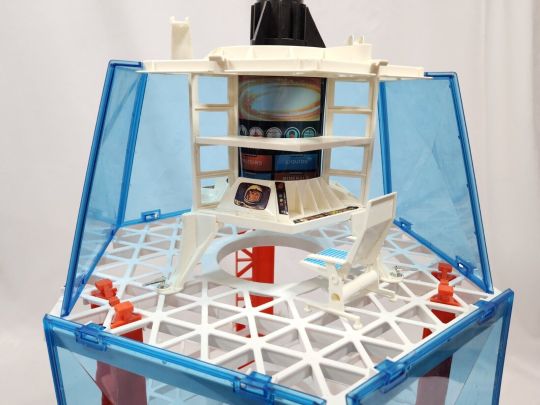
The Space Station play set in all its glory.
The Space Station was modular, and you could make it taller or shorter by adding or subtracting pieces of the red pylons. The idea was for kids to have several Space Stations of varying heights, because Major Matt Mason had a ziipline accessory that enabled him to travel between them.
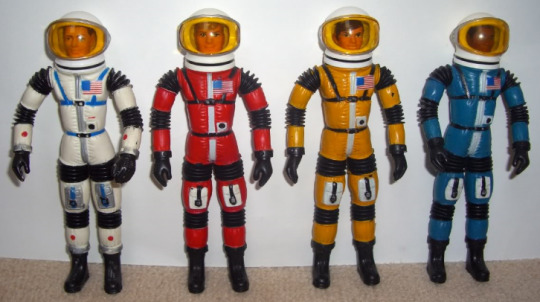
The Moon Crew in their color-coded spacesuits.
In fact, there were so many gadgets and accessories that, even with mid-1960s prices, I’m sure many parents would have had to take out a second mortgage in order to afford them all.
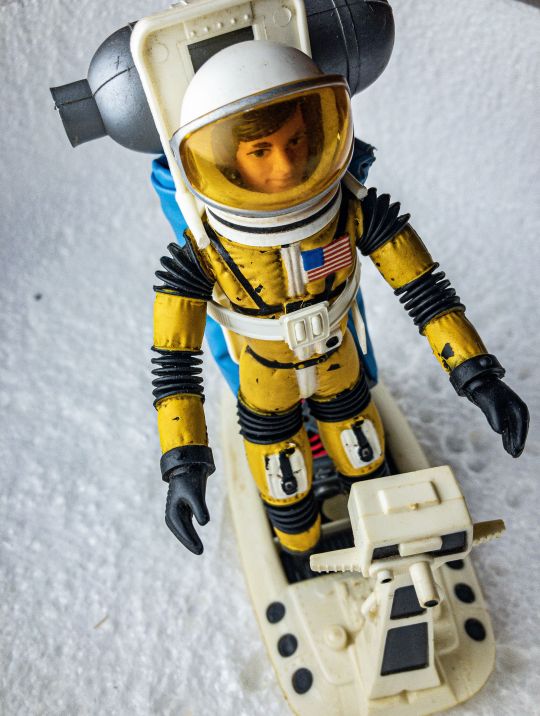
Doug Davis wearing a specialized back pack while riding his Space Sled.
Unfortunately for me, the only accessory I ever received was the rather prosaic Cat Trac. It wasn’t as exciting as the Space Sled, or as zippy as the Jet Pack (there were a few different versions), or battery-powered like the Space Crawler. Nevertheless, I used my imagination to make the most of it.
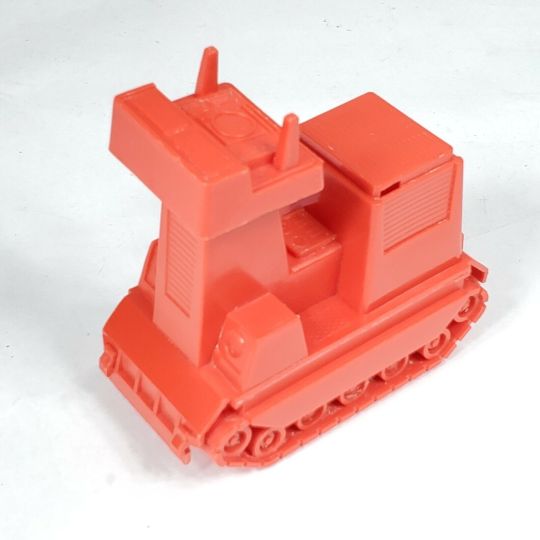
The Cat Trac: looked cool at first glance, but it was only a hollow piece of molded plastic. Would’ve scored much higher on the coolness scale if the tracks at least moved.
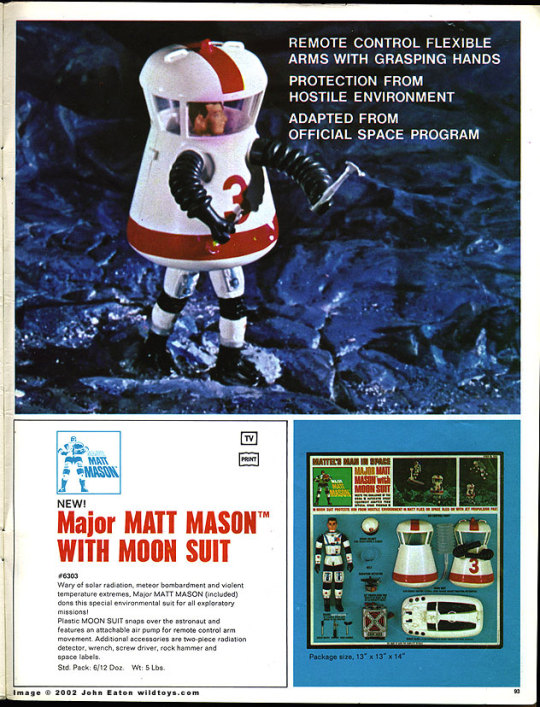
The Moon Suit, based on an actual prototype developed by Grumman.

The Space Bubble was essentially a rickshaw on the Moon: One man did all the work while another just relaxed in the back.
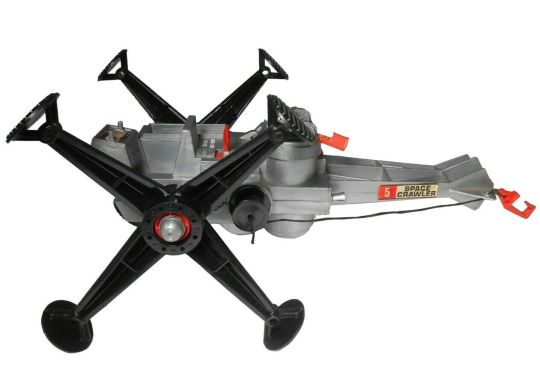
The Space Crawler, the creme de la creme of the Major Matt Mason transport toys. This guy crawled along at a pretty decent clip, and due to its “legs” it could cover some rugged terrain.
It wasn’t long, however, before someone at Mattel became bored with the relatively realistic theme of the Major Matt Mason line. Their solution: introduce science fiction elements to make things more exciting.
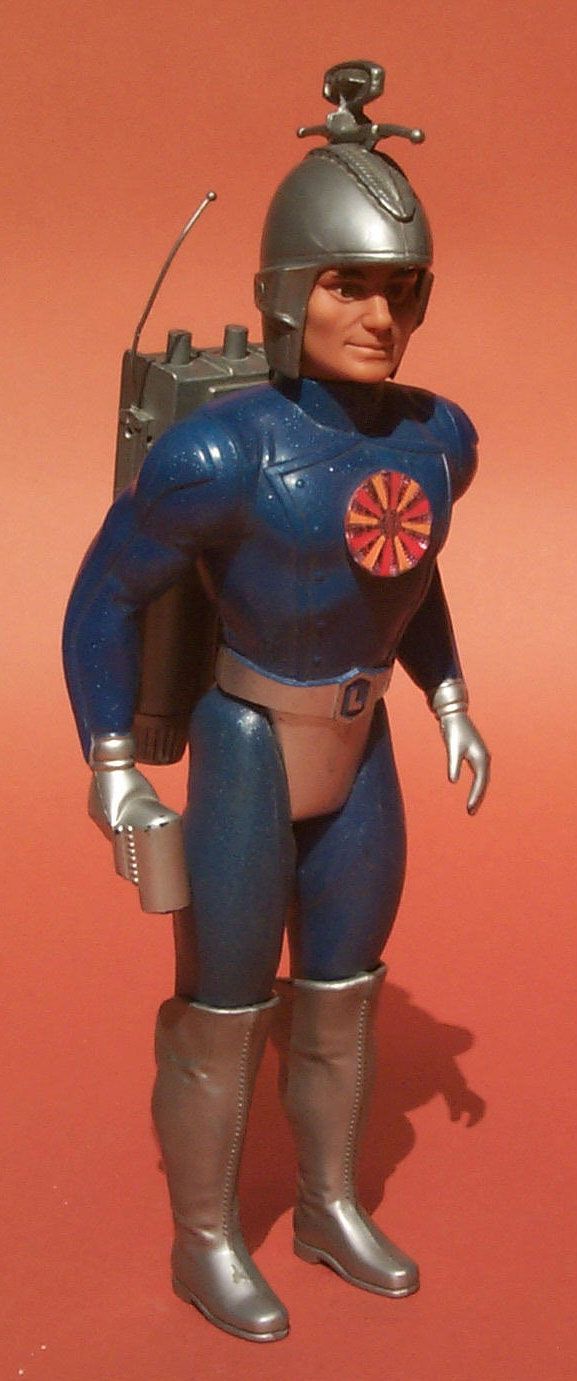
Captain Lazer, mysterious alien friend to Major Matt Mason and crew.
The first was the introduction in 1967 of Captain Lazer, who was so different from the rest of the line that there is speculation that he was intended for another line of figures entirely, or acquired from a Japanese company (his helmet reminds me of the Toei tokusatsu hero Captain Ultra, which was airing in Japan at the time).
Captain Lazer was 12 - almost 13 - inches tall, towering over Mason and the other astronauts. His body was made of hard plastic The head rotated at the neck, the arms rotated at the shoulders, and the legs rotated at the hips, but that was the extent of his articulation. He had battery powered glowing red eyes and chest plate, as well as the laser pistol that was attached permanently to his hand. There were attachments that connected to the pistol to change its appearance. All in all, he looks like a pulp magazine or Golden Age comic book version of a space hero.
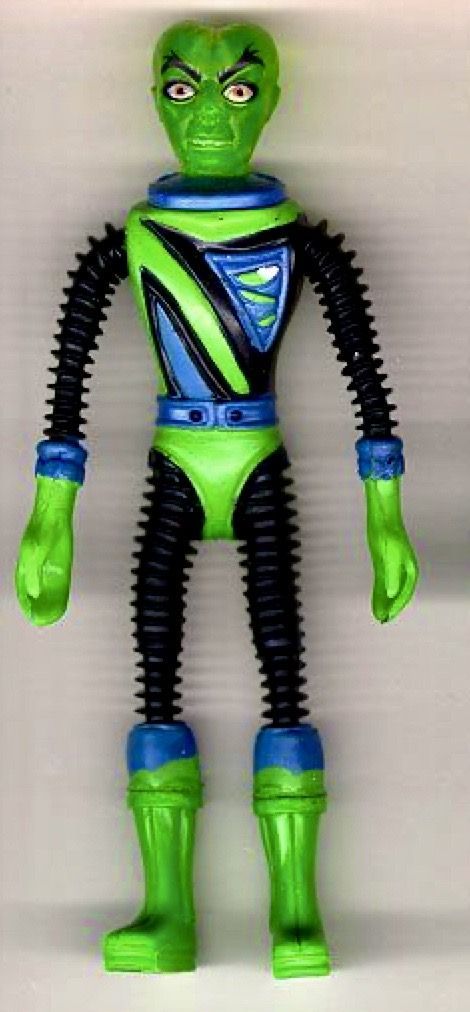
Good guy alien Callisto.
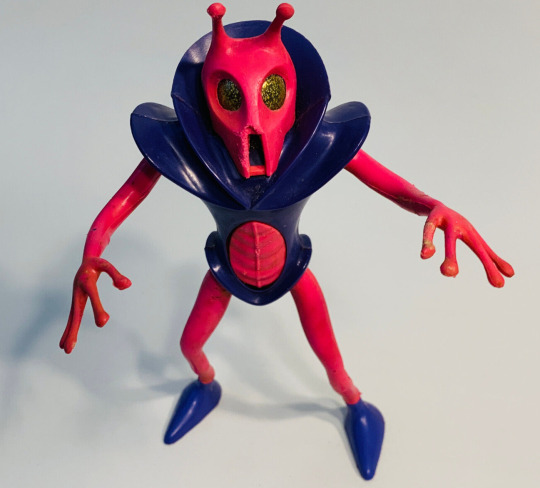
Evil alien Scorpio.
Then there were the aliens Callisto and Scorpio. These were both in scale with the astronaut figures, and came with various gimmicks and accessories. Callisto, listed as Mason’s friend from Jupiter, had a rubber and wire armature body. Scorpio was an evil alien had battery-powered glowing eyes.
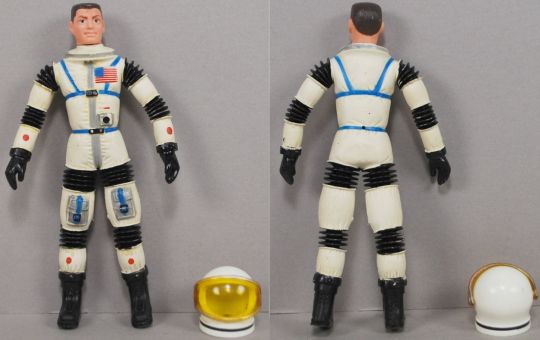
A first edition version of the good Major.
The astronauts’ equipment became typical science fiction props, like the Firebolt Space Cannon, assorted hand-held weapons, the Super Power Set (think Ripley’s exosuit cargo loader from Aliens), and the Gamma Ray-Gard (a projectile firing toy).

Major Matt Mason even got his own Big Little Book. This is the only surviving piece of my MMM collection.
I had a lot of fun with the few Major Matt Mason toys I had, as did everyone I knew who had some. There were, unfortunately, two major problems with the figures that reduced their enjoyment and playability factors.
First, the wire armatures were extremely thin and broke within a matter of days. The wire would then stick out through the rubber body, poking you in the hand every time you picked the figure up. Meanwhile, the limb the wire was attached to would flop around uselessly.
Second, the paint on the rubber bodies began to flake off almost immediately, exposing the black base. I remember finding paint flecks all over my hands and clothes each time I played with the figures. At a price in 1966 of around $2.37 (approximately $22.00 today), the figures weren’t inexpensive, and I know my folks couldn’t afford to replace them.
Sadly, just as America lost its interest in the space program due to severe problems at home (the Vietnam War, Watergate, the oil crisis, rampant inflation), so did kids lose interest in Major Matt Mason. Mattel cancelled the line abruptly in 1972 and never looked back.
Nevertheless, the Major and his crew have remained favorites of that generation. Tom Hanks has been trying to get a Major Matt Mason film made for years.
And the Major was a big hit with NASA. He reportedly been to space as a crew member on several missions of the space shuttle, including Senator John Glenn’s shuttle mission in 1998. Heck, I wouldn’t be surprised if you found him somewhere on the International Space Station.
youtube
#Major Matt Mason#Sgt. Storm#Doug Davis#Jeff Long#astronaut#Captain Lazer#Callisto#Scorpio#Mattel#action figures#toys
114 notes
·
View notes
Text
Black Astronauts

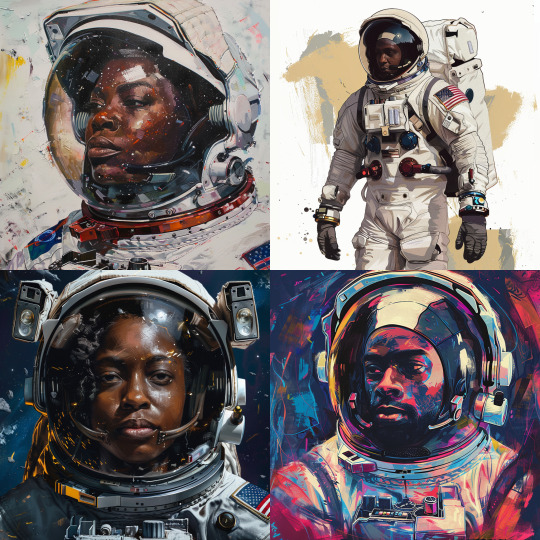
Yesterday I was at the Natural History Museum with my ten year old daughter and we saw the Space movie - - for the umpteenth time. It never gets old. So I was inspired to highlight black astronauts and black people in space.
From Perplexity:
Here are some famous black astronauts:
Robert H. Lawrence Jr.
He was the first Black astronaut selected for a space program in June 1967. Tragically, he lost his life in an aircraft accident later that year[2].
Guion S. Bluford Jr.
In 1983, Bluford became the first African-American to travel to space, aboard the Challenger space shuttle. He later flew three additional shuttle missions[1].
Mae C. Jemison
She became the first Black woman to travel to space in 1992, aboard the space shuttle Endeavour[5].
Frederick D. Gregory
He became the first Black astronaut to pilot a space shuttle and later flew as the first Black commander of a space shuttle[2].
Ronald E. McNair
He was the second African American to fly in space and tragically lost his life in the Space Shuttle Challenger disaster in 1986[5].
These astronauts have made significant contributions to space exploration and have inspired future generations with their achievements.
Citations:
[1] https://www.nytimes.com/2019/07/16/us/african-american-astronauts.html
[2] https://www.nasa.gov/history/honoring-black-astronauts-during-black-history-month-2023/
[3] https://www.nasa.gov/history/honoring-african-americans-in-space/
[4] https://nmaahc.si.edu/explore/stories/african-american-achievement-nasa
[5] https://themarsgeneration.org/10-black-americans-who-made-extraordinary-contributions-to-space-exploration/
From Gemini:
America's Black Astronauts: Pioneering the Skies and Breaking Barriers
In the annals of African American history, the achievements of Black astronauts shine brightly. Overcoming societal barriers and racial prejudice, these individuals soared into the vast unknown, inspiring generations and proving that the pursuit of scientific exploration transcends earthly limitations. Let's celebrate some of America's most famous Black astronauts and their remarkable journeys:
Guion Bluford: In 1983, aboard the Space Shuttle Challenger, Bluford became the first Black American in space. A fighter pilot and engineer, he logged four spaceflights, conducting scientific experiments and advocating for STEM education.
Ronald McNair: A physicist and astronaut, McNair followed Bluford into space in 1984. He perished tragically in the Challenger disaster of 1986, leaving behind a legacy of scientific contributions and dedication to education.
Frederick Gregory: Pilot and astronaut Gregory made history in 1985 as the first Black American to command a Space Shuttle mission. He flew on multiple missions and advocated for diversity in the STEM fields.
Charles Bolden: An accomplished pilot and Marine Corps Major General, Bolden became the first Black astronaut to lead NASA in 2009. He served eight years, overseeing historic missions like the final Space Shuttle flights and the launch of the Orion spacecraft.
Bernard Harris: Physician and astronaut Harris holds the record for most spacewalks by a Black American, logging seven missions throughout his career. He conducted crucial medical research and served as Chief of the Astronaut Office.
Stephanie Wilson: An engineer and astronaut, Wilson became the first Black woman to command the International Space Station in 2010. She flew on three Space Shuttle missions and remains a strong advocate for science education and diversity in STEM.
Joan Higginbotham: An engineer and astronaut, Higginbotham served as a mission specialist on two Space Shuttle missions, conducting scientific experiments and demonstrating the power of women and minorities in space exploration.
Victor Glover: A pilot and astronaut, Glover made history in 2020 as the first Black person to pilot a SpaceX Crew Dragon. He commanded an International Space Station mission and continues to inspire future generations.
Further Reading:
For Middle School Students:
Reaching for the Stars: The Inspiring Story of Mae Jemison, the First African American Woman in Space by Catherine Coleman
Hidden Figures: The American Dream and the Untold Story of the Black Women Mathematicians Who Helped Win the Space Race by Margot Lee Shetterly
Astronaut Annie by Jan Astronaut
Whoosh! Blast Off to the Moon by Paul Shifrin
Rocket Men: The Daring Pilots Who Took Us to the Moon by Robert Kurson
For High School Students:
Light Years: The Legacy of America's First Black Astronauts by Colin Stuart
Black Wings: The American Dream of Flight by Cheryl A. Hill
Carrying the Dream: The Story of the Tuskegee Airmen by Margot Lee Shetterly
An Astronaut's Guide to Earth by Thomas Pesquet
Packing for Mars: The Curious Science Behind Colonizing a New Planet by Mary Roach
These are just a few examples, and countless other books and resources chronicle the remarkable stories of Black astronauts. By learning about their journeys, we gain a deeper understanding of the struggles and triumphs of Black Americans in science and technology, reminding us that the pursuit of knowledge and exploration knows no bounds.


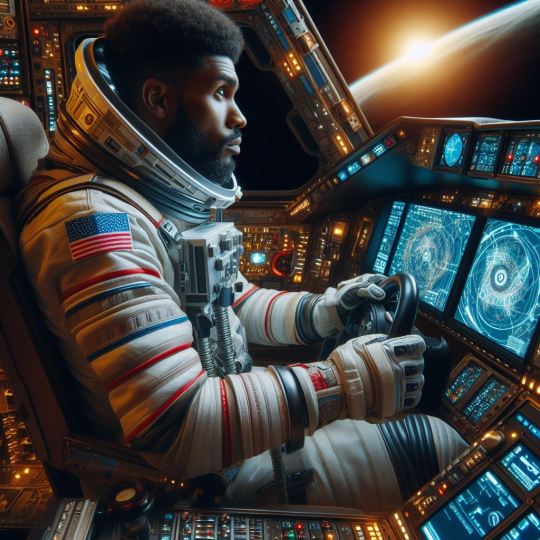

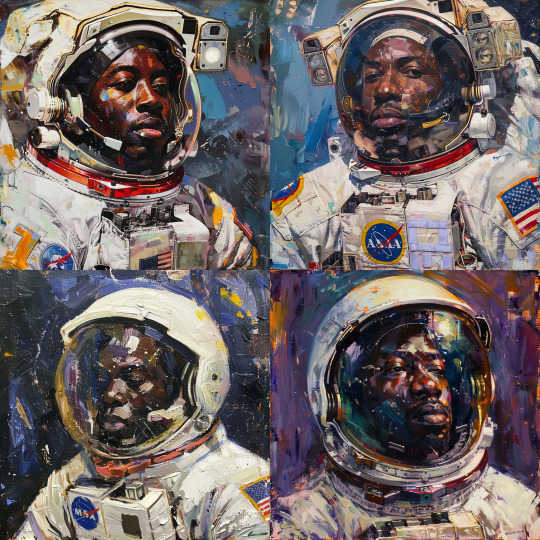



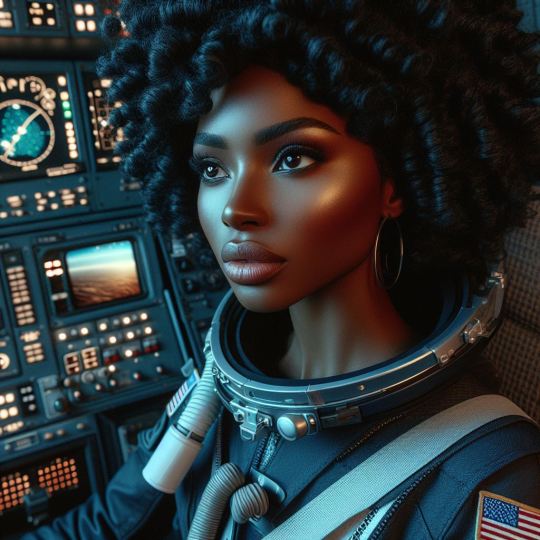
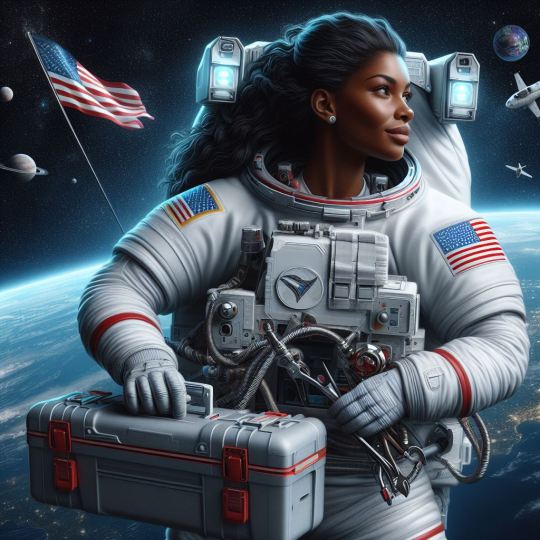


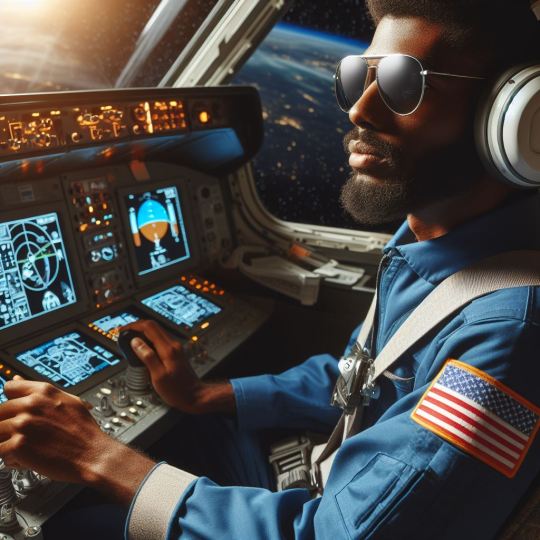



#black history month#blackhistorymonth#africanamericanhistory#dalle3#midjourney#afrofuturism#astronauts#mae jemison#africanamericanhistorymonth#blackinspace
11 notes
·
View notes
Text
In our world, Ed Dwight preserves the past.
#don't even care about the article's tone#the man deserves more recognition#also as a Monument Mythos fan I'm over the moon#pun intended#monument mythos#the monument mythos#wendigoon
15 notes
·
View notes
Text

Challenger roars off the pad during STS-8. August 30, 1983.
STS-8 was the first night launch of the Space Shuttle Program. It also carried the first Black American in space, Guion Bluford. The primary mission of STS-8 was the deployment of the Indian communications and weather observation satellite, INSAT-1B. Once deployed, INSAT-1B used its own PAM-D booster to place it into a geostationary orbit.

Deployment of INSAT-1B, taken from Challenger's flight deck.
Secondary payload included the payload flight test article, and stand-in for a delayed NASA communications satellite. The PFTA would be used to test the shuttle's Remote Manipulator System, also known as Canadarm. Additional scientific experiments were carried out, particularly the study of biological materials in electric fields under microgravity, and research into space adaptation sickness.

Canadarm lifts the PFTA out of the payload bay.

STS-8 crew portrait. From left: Mission Specialists Dale Gardner Guion Bluford, and William Thornton; Pilot Daniel Brandenstein; Commander Richard Truly.
Challenger touched down on Runway 22 at Edwards Air Force Base on September 5, 1983, completing STS-8. This was the first night landing of the Space Shuttle program.

Challenger just moments prior to landing at Edwards Air Force Base.
NASA 1, 2, 3, 4
5 notes
·
View notes
Text
MOGAI BHM- Belated Day 21!
happy BHM! today i’m going to be talking about some famous ‘black firsts’!
Black Firsts in Science-
In 1965, David Harold Blackwell became the first Black member of the National Academy of Sciences
Robert H. Lawrence was the first Black astronaut; Mae Jemison was the first Black female astronaut, and Guion Bluford was the first Black astronaut to actually travel in space
Thomas Jennings was the first Black patent holder in the U.S, and Judy Reed was the first Black woman patent holder in the U.S
Daniel Hale Williams performed the first successful heart surgery
James Smith was the first officially trained Black American doctor
Robert Freeman was the first Black American dentist
Black Firsts in Politics-
Macon Allen was the first Black American admitted to a law school, and Charlotte Ray was the first Black woman admitted to a law school.
William Henry Hastie was the first Black federal Judge, and Constance Motley was the first Black female federal Judge
Thurgood Marshall was the first Black SCOTUS Justice
Alexander Lucius Twilight was the first Black state-elected official
Pierre Landry was the first Black city mayor, and Carl Stokes was the first Black mayor of a major US city
Jonathan Wright was the first Black state supreme court justice
Hiram Revels was the first appointed Black US Senator, and Edward Brooke was the first elected Black US Senator
P.B.S Pinchback was the first appointed Black state governor
Crystal Fauset was the first Black female legislator in the US
Shirley Chisholm was the first Black female U.S representative
Carol Braun was the first Black female U.S Senator
Joseph Rainey was the first Black person to serve in the US House of Representatives
Joseph Jenkins Roberts was the first African-American president of any nation (Liberia)
Black Firsts in Education-
Theodore Wright was the first Black graduate of an Ivy League School
Lucy Stanton was the first Black woman to graduate college in America
Charles Reason was the first Black college professor
Daniel Payne was the first Black college president
Dr. David Peck was the first Black person to graduate from medical school
Alexander Lucius Twilight was the first Black person to receive a degree from an American college
Mary Patterson was the first Black American woman to earn a B.A
Fanny Coplin was the first Black woman to become principal of a school
Richard Greener was the first Black Harvard graduate
Black Firsts in the Arts-
Lucy Terry was the first Black American poet and Phillis Wheatley was the first published Black American poet
Gwendolyn Brooks was the first Black Pulitzer Prize winner
William Brown was the first Black American novelist, and Harriett Wilson was the first Black female American novelist
Toni Morrison was the first Black winner of the Nobel Prize for Literature
Francis Johnson was the first published Black American musical composer
Marian Anderson was the first Black member of the Metropolitan Opera
Harry Swan was the first Black American to found a record label, Black Swan Records
Count Basie was the first Black person to win a Grammy, and Ella Fitzgerald was the first Black woman to win a Grammy
William Lane was the first nationally famous Black dancer, and Arthur Mitchell was the first Black principal dancer in a major dance company
Oscar Micheaux was the first Black film director
Hattie McDaniel was the first Black person to win an Oscar, and Juanita Hall was the first Black person to win a Tony
William Still was the first Black American to both direct a major orchestra and have their composition performed by a major orchestra
Black Firsts in Sports-
Oliver Lewis was the first Black jockey to Win Kentucky Derby
Moses Walker was the first Black professional baseball player
John Shippen Jr. was the first Black professional Golfer
Marshall “Major” Taylor was the first Black world cycling champion
George Poage was the first Black Olympic medalist at the Summer games, and John Taylor was the first Black Olympic gold medalist at the Summer games
Jackie Robinson was the first 20th century Black MLB player
Rajo Jack de Soto was the first Black professional race car driver
Willie Thrower was the first Black NFL quarterback
Willie O’Ree was the first Black NHL player
Alice Coachman was the first Black woman to win an individual gold medal at the summer olympic games
tagging @metalheadsforblacklivesmatter @bfpnola @intersexfairy
29 notes
·
View notes
Text
friendly reminder that cuban arnaldo tamayo mendez went to space 3 years (i think?) before guion bluford
#so guy bluford was only the first african-USamerican in space#everyone always forgets mendez it annoys me
2 notes
·
View notes
Text
Star Trek in 1966 (Nichelle Nichols) was the first time the future was imagined with Black people. The first Black astronaut, Guion Stewart Bluford, Jr. was in 1983. Mae C. Jemison was the first Black woman in space.
2 notes
·
View notes
Text
From the Sci-Fi 5 Archive: on this day in 1983, astronaut Guion "Guy" Bluford became the first African-American in space when space shuttle mission STS-8 launched.
0 notes
Text
Events 8.30 (after 1940)
1940 – The Second Vienna Award reassigns the territory of Northern Transylvania from Romania to Hungary.
1941 – The Tighina Agreement, a treaty regarding administration issues of the Transnistria Governorate, is signed between Germany and Romania.
1942 – World War II: The Battle of Alam el Halfa begins.
1945 – The Japanese occupation of Hong Kong comes to an end.
1945 – The Supreme Commander of the Allied Forces, General Douglas MacArthur lands at Atsugi Air Force Base.
1945 – The Allied Control Council, governing Germany after World War II, comes into being.
1959 – South Vietnamese opposition figure Phan Quang Dan was elected to the National Assembly despite soldiers being bussed in to vote for President Ngo Dinh Diem's candidate.
1962 – Japan conducts a test of the NAMC YS-11, its first aircraft since World War II and its only successful commercial aircraft from before or after the war.
1963 – The Moscow–Washington hotline between the leaders of the U.S. and the Soviet Union goes into operation.
1967 – Thurgood Marshall is confirmed as the first African American Justice of the Supreme Court of the United States.
1974 – A Belgrade–Dortmund express train derails at the main train station in Zagreb killing 153 passengers.
1974 – A powerful bomb explodes at the Mitsubishi Heavy Industries headquarters in Marunouchi, Tokyo. Eight are killed, 378 are injured. Eight left-wing activists are arrested on May 19, 1975, by Japanese authorities.
1974 – The Third World Population Conference ends in Bucharest, Romania. At the end of the ceremony, the UN-Romanian Demographic Centre is inaugurated.
1981 – President Mohammad-Ali Rajai and Prime Minister Mohammad-Javad Bahonar of Iran are assassinated in a bombing committed by the People's Mujahedin of Iran.
1983 – Aeroflot Flight 5463 crashes into Dolan Mountain while approaching Almaty International Airport in present-day Kazakhstan, killing all 90 people on board.
1983 – STS-8: The Space Shuttle Challenger takes off on the first night launch of the shuttle program. Guion Bluford becomes the first African-American in space on this mission.
1984 – STS-41-D: The Space Shuttle Discovery takes off on its maiden voyage.
1991 – Dissolution of the Soviet Union: Azerbaijan declares independence from Soviet Union.
1992 – The 11-day Ruby Ridge standoff ends with Randy Weaver surrendering to federal authorities.
1995 – Bosnian War: NATO launches Operation Deliberate Force against Bosnian Serb forces.
1998 – Second Congo War: Armed forces of the Democratic Republic of the Congo (DRC) and their Angolan and Zimbabwean allies recapture Matadi and the Inga dams in the western DRC from RCD and Rwandan troops.
2002 – Rico Linhas Aéreas Flight 4823 crashes on approach to Rio Branco International Airport, killing 23 of the 31 people on board.
2008 – A Conviasa Boeing 737 crashes into Illiniza Volcano in Ecuador, killing all three people on board.
2014 – Prime Minister of Lesotho Tom Thabane flees to South Africa as the army allegedly stages a coup.
2021 – The last remaining American troops leave Afghanistan, ending U.S. involvement in the war.
2023 – Gabonese coup d'état: After Ali Bongo Ondimba's reelection, a military coup ousted him, ending 56 years of Bongo family rule in Gabon.
0 notes
Text
Sooo what do we all think about the Bluford High series? I don’t think I’ve actually read all 23 books in the series but, after jogging my memory, I’ve read (but like a whilleeee ago so my memory is fuzzy) Blood is Thicker, Survivor, Brothers in Arms, The Gun, and a few more that I can’t recall.
I think they’re like really good but I don’t hear a lot of people mention them (tbf it could just be that I’m not in the right circles), they cover a wide range of topics and issues. Here’s the Wikipedia blurb, “The Bluford Series is a widely read collection of contemporary American young adult novels set in the fictional inner-city high school of Bluford High in Southern California. Bluford is named for Guion "Guy" Bluford, the first African-American astronaut. The series was created and published by Townsend Press and was co-distributed by Scholastic. As part of an effort to promote reading in underfunded school districts, Townsend Press originally made the Bluford Series available to schools for a dollar each. As of 2018, over 11 million Bluford Series novels were in print.”
#bluford series#Bluford books#Bluford High Series#Survivor#The Gun#Blood is Thicker#Brothers in Arms
0 notes
Text
Missions of Challenger (OV-099)
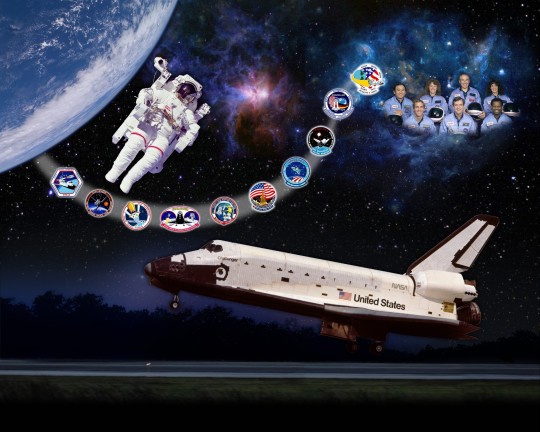
"CAPE CANAVERAL, Fla. -- This orbiter tribute of space shuttle Challenger, or OV-099, hangs in Firing Room 4 of the Launch Control Center at NASA's Kennedy Space Center in Florida. Challenger's accomplishments include the first night launch and first African-American in space, Guion Bluford, on STS-8, the first in-flight capture, repair and redeployment of an orbiting satellite during STS-41C, the first American woman in space, Sally Ride, on STS-7, and the first American woman to walk in space, Kathryn Sullivan, during STS-41G. Challenger is credited with blazing a trail for NASA's other orbiters with the first night landing at Edwards Air Force Base in California on STS-8 and the first landing at Kennedy on STS-41B. The spacewalker in the tribute represents Challenger’s role in the first spacewalk during STS-6 and the first untethered spacewalk on STS-41B. Crew-designed patches for each of Challenger’s missions lead from Earth toward a remembrance of the STS-51L crew, which was lost 73 seconds after liftoff on Jan. 28, 1986. Five orbiter tributes are on display in the firing room, representing Atlantis, Challenger, Columbia, Endeavour and Discovery."
Graphic design credit: NASA/Lynda less
Date: July 29, 2010
NASA ID: KSC-2010-4451
#Space Shuttle#Space Shuttle Challenger#Challenger#OV-099#Orbiter#NASA#Space Shuttle Program#STS-6#STS-7#STS-8#STS-41-B#STS-41B#STS-11#STS-41-C#STS-41C#STS-13#STS-41-G#STS-41G#STS-17#STS-51-B#STS-51B#STS-51-F#STS-51F#STS-61-A#STS-61A#STS-51-L#STS-51L#July#2010#my post
33 notes
·
View notes